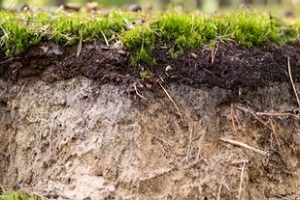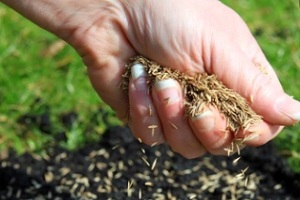 When spring approaches, many homeowners’ thoughts turn to the appearance of their yard and garden. The front lawn often gets most of the attention because it is the first thing people see when they pull up to a home. For many people, the first step in sprucing up the yard is planting some grass seed.
When spring approaches, many homeowners’ thoughts turn to the appearance of their yard and garden. The front lawn often gets most of the attention because it is the first thing people see when they pull up to a home. For many people, the first step in sprucing up the yard is planting some grass seed.
Planting grass seed seems relatively straightforward, but there are a surprising number of factors that can influence the results. One of the biggest considerations is the use of topsoil.
When Can You Use Topsoil?
If you are considering spreading topsoil over your grass seeds after planting them, there are a few things that you need to keep in mind. Many people believe that this approach will protect the seed and help it germinate, but grass seeds cannot push through heavy materials like topsoil when they are sprouting. Grass seeds are very small, and they are very sensitive while they are in the germination stage. Their oblong shape and small size makes it difficult for them to push their way through topsoil. This means that you could end up suffocating the grass seedlings before they have a chance to grow.
However, that does not mean you should leave it uncovered. Grass seeds should never be left exposed to the elements. Adding topsoil to your lawn before planting grass seeds is a good approach, as long as you amend and aerate it before seed dispersal. After laying your topsoil, work around 4 inches of organic material into it to create a fertile soil environment.
If you have any doubts about the growing conditions, you can use a pH meter to check that the topsoil has a pH of somewhere between 6 and 7 to give your seeds the best chance of success. If your soil does not fall within this range, you can purchase treatments that will raise or lower the pH as needed. If the pH falls below 6, look for a product for acidic lawns, while soil with a pH above 7 needs products designed for alkaline lawns to bring the pH down. Be sure to loosen and aerate the lawn again after addressing the pH level.
How Deep Should You Plant Grass Seeds?
The recommended depth for planting grass seed is around 1/8 to 1/4 of an inch below the surface. The seeds can be dispersed using a spreader or by hand across an aerated lawn. Aeration enables the soil to be broken up just enough that the seeds are able to go below the surface without getting completely covered in a thick layer of topsoil.
As a general rule of thumb, the University of Minnesota Extension recommends that you should only be able to see about 10 percent of the seed’s shape above the ground when it has been tilled into the soil. You should start to see your grass seeds emerge around three weeks later.
When Should You Plant Grass Seeds?
Spring and fall are the best times of year to plant cool season grass seeds as they prefer warm soil and cool air. However, warm season grasses can be planted in the South from late spring to mid-summer. It is best to wait until there is no more chance of late frost and the temperatures during the day have hit the 80s. Ensure that whatever grass seeds you use match your climate as well as your lawn’s unique properties, such as the amount of shade and sun that it gets and the amount of time you are willing to spend on maintaining your lawn.
How Can You Help Grass Seeds Thrive?
While topsoil is a great choice for planting your seeds, it is a poor choice as a protective layer. Instead, you can use materials such as straw, hay or mulch to protect your seeds from wind and pests. Spread a thin layer of no more than 1/4 of an inch of this material across the seeds to protect them and help retain moisture.
 When these mulching materials eventually degrade, they will add nutrients to the soil to help ensure that you grow a beautiful lawn. Straw is a particularly good choice for grass because it works to prevent rot while preventing the drought conditions that can stop grass from growing.
When these mulching materials eventually degrade, they will add nutrients to the soil to help ensure that you grow a beautiful lawn. Straw is a particularly good choice for grass because it works to prevent rot while preventing the drought conditions that can stop grass from growing.
Some people mix their topsoil with a seed starter fertilizer to give the seeds a better foundation. These products are available for a broad range of soil types in most home improvement stores and soil suppliers.
Can You Plant Grass Seed on an Existing Lawn?
If you have existing grass that you are trying to replace with new grass, it is best to remove the old grass entirely before you plant new grass seeds. Although it is possible to place a layer of topsoil over the grass and reseed the area, the grass that is below the topsoil will eventually grow up through it and cause problems.
If grass will only be planted across a small area, you can use hand tools such as shovels and rakes to dig out old sod, weeds and other vegetation. This is a fairly quick and easy process. Be careful to preserve as much good topsoil you encounter as possible. You can also purchase topsoil that has the right nutrients to help your grass grow and use it to create a more even surface.
After removing old sod and weeds, you will want to loosen the soil so that the roots of the new grass seeds will be able to grow through it easily. A digging fork is sufficient for a smaller yard, while a core aerator can be rented for a bigger area. Fill in any low spots while the soil is bare using a half-and-half mixture of sand and topsoil.
Get in Touch With Dirt Connections
Dirt Connections offers a broad range of topsoil, fill dirt and bio mix soils. Reach out today to learn more or schedule your dirt delivery in the Northern Virginia area.
Summary

Dirt Connections was started with one goal in mind: providing quality residential and commercial construction services to clients on time and on budget. Reach out for more information on how we can support your next project.
For your convenience our estimates are free and by appointment. Call 703-940-9949 for a free estimate today!









































